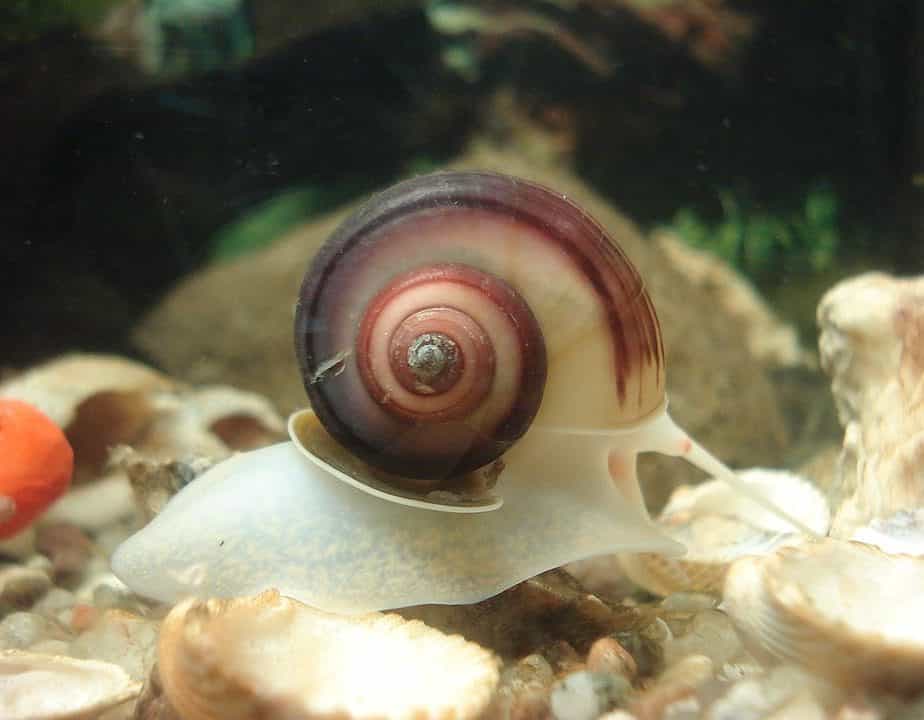
Unwanted mollusks, such as snails and slugs, are a very common problem and they often come as a surprise to fish keepers. Of course, snails do not materialize out of nothing.
Usually, eggs of snails and slugs get into aquariums with new plants or other items. The eggs are difficult to spot. Pest snails are also extremely hardy and most species do not need a mate to reproduce.
- It is a good practice to quarantine new plants in a separate tank for at least a few days before adding them to your tank.
- If snails do appear, prioritize keeping the tank clean and free of algae, and avoid overfeeding your fish.
- Keep removing snails
- Consider adding an Assassin Snail
You should be able to eliminate unwanted snails and slugs from your tank over time if you are diligent about taking measures.
I DID NOT PUT SLUGS OR SNAILS IN MY AQUARIUM – WHERE DID THEY COME FROM?
Although you did not intentionally add slugs and snails to your fish tank, you certainly did put them there inadvertently.
Snails are extremely hardy creatures, they can emerge from eggs in even suboptimal conditions and proliferate quickly. Most fish keepers bring them in unknowingly with either the water around new fish in a bag or live plants from pet stores.
MAIN SOURCES OF SNAILS AND CONTRIBUTING FACTORS
Adding Live Plants
Plants grow in conditions that are most likely also perfect for snails and slugs, including their eggs. Most fish keepers get their live plants from pet stores or aquatic shops, and it is very common for those places to have some snails in the tanks.
It is very easy to not notice the eggs because they are clear, tiny, and often attached to the plant itself. Many of the eggs will not hatch because of the sudden change in the environment in the new tank. However, even a couple of live offspring could be enough to overtake the whole fish tank if the conditions are right.
When You Buy Fish, Plants, And Other Items From Pet Store
Although it is especially easy to accidentally bring snails when you purchase live plants, other items, and the water you bring with fish, could also be sources of eggs.
If you transfer decorations or gravel from one tank to another, snail eggs could migrate that way. Even the water in the little bag your new fish comes from could hide some eggs.
Overfeeding Your Fish
If you give your fish more food than they consume, the aquarium will get dirty and will have more decaying debris for the pest snails to thrive.
Avoid overfeeding your pet fish.
Give them just what they can eat within a few minutes once or twice a day. That way you at least do not provide all the extra nutrients that would, after completing a cycle, support the growth of the snail and slug population.
Algae In Your Tank
Excess nutrients and ample light increase algae in aquariums.
Snails thrive on algae, and fish keepers often welcome certain kinds of these mollusks to combat algae and waste in the tank. Of course, they bring in snails in a controlled manner and take measures to prevent proliferation.
Snails that are brought in by accident will help control algae too and might not even reproduce all that much if the amount of nutrients in the tank is limited.
Either way, if your aquarium is hosting unwanted snails and the snails seem to be multiplying, you should target algae as one of the main sources that support the growth of the snail population.
Many Do Not Need A Mate To Reproduce
Some of the snails that people usually add to their aquariums on purpose do need a mate of the opposite sex to reproduce. Most snails, however, are hermaphrodites and can deposit and fertilize eggs on their own. So a single specimen could lead to an infestation of snails.
Sails Are Extremely Hardy
Pond snails and other species of snails and slugs that are not commonly cultivated by fish enthusiasts are also extremely hardy. Unlike some of the more popular snails, such as Nerites, for example, they do not need strict parameters to survive.
Most snails tolerate a wide range of temperatures, acidity, and hardness. They may not lay as many eggs as in conditions that are optimal but they can still thrive and proliferate.
Many Snails And Their Eggs Are Very Hard To See
Eggs are difficult to spot but even grown snails can be a challenge to locate in the aquarium. There are several reasons for that.
Snails can hide well and leaving even one or two in the tank by accident could lead to a repopulation within weeks.
In addition, some snails are nocturnal and they burrow in sand or decorations during the day. With little activity, they are much harder to spot.
Again, if you are dealing with an infestation of snails, there is always a chance that a snail or an egg is left behind in the tank.
Are Snails And Slugs Bad For The Aquarium?
Snails can be great for the fish tank – most species are excellent at consuming decaying food and even dead fish or eggs. They eat algae, too.
Snails rarely eat plants and they usually do not threaten fish, so they are safe in that sense.
As it is understood, you don’t need to make any changes to the environment of your tank to allow them to thrive – they already flourish without any input from you as the fish keeper.
Although snails clean the tank, they also produce some waste. They can proliferate in excess. However, if you take all the measures, including avoiding overfeeding fish and keeping your tank clean and free of algae, their population growth should not get out of control.
Please read our post on what snails do for fish tanks.
HOW TO PREVENT SNAILS AND SLUGS FROM APPEARING
Without a question, preventing snails from appearing in your aquarium is much preferred to dealing with them when they are there.
Keep New Plants And Items From Other Tanks In A Separate Container For At Least A Week
If you quarantine new plants and items, you will notice if the tank with water has eggs or if snails are appearing. Even a few days could be sufficient but many fish keepers who have dealt with snail infestation before prefer to quarantine for a week.
The Fish Tank Should Not Be In A Spot With Too Much Direct Sunlight
The fish do need some light but light in abundance can be stressful for the fish and also lead to excess growth of algae. That would, of course, be a food source for snails.
Avoid Overfeeding Your Fish
This recommendation is basic and important for several reasons. It is, however, essential, to minimize the chances of having an uncontrolled proliferation of pest snails.
Avoid giving your fish more food than they can consume within 2-3 minutes. Feeding once or twice a day is usually enough. It is okay a little more frequently and you want to make sure all fish get some food. That can be helpful in large tanks with many fish with different temperaments. It is more important to never give them more than what they eat within a few minutes. You don’t want any leftover food in the tank.
HOW TO REMOVE SNAILS AND SLUGS
If unwelcome snails and slugs already inhabit your aquarium, you will need to implement some routines to reduce and eventually get rid of them entirely.
Consider Adding Fish That Eat Snails
There are species of fish that eat snails. It is not easy to find the right tank mates for your already-established habitat. Of course, any newly added fish would have to be a good match in terms of the parameters you maintain in your aquarium, including temperature, acidity, hardness, and so on.
Any new fish you add would also have to be congenial to the established inhabitants of your fish tank.
Another problem is that fish that are great at eating snails tend to be quite large and they need fish tanks that are bigger than people usually have in their homes.
Some prime examples of fish that eat snails are the following:
- Loach fish, including clown, yoyo, zebra loaches
- Goldfish
- Gourami
- Cory Catfish
- Bala shark
- Puffers
I would like to highlight cory catfish, particularly Pygmy Cori Catfish as an option if you want a snail-eater that is low maintenance.
There are many kinds of Cory Catfish and most of them are great fish to keep. Pygmy Cory Catfish rarely exceed 2.5 cm (1 inch) in size. They are docile, easily content, and don’t need a large tank with very strict parameters.
Interestingly, Betta fish also like to snack on snails. Of course, they are very peculiar tank mates and it is often not easy to just add a Betta to a community of fish.
Goldfish are quite easy to keep but they grow to be large, too, and can also be particular tank mates.
When it comes to using your fish as a way to check the population of snails, note that many fish cannot get snails out of their shells. So, you might have to crush them for your fish. Not every fishkeeper likes this aspect of the issue.
Get An Assassin Snail
Assassin snails are safe for fish and a menace for snails and slugs!
Research the parameters they need before adding them to make sure your snail can survive happily in your tank.
Assassin snails are not hermaphrodites, so they do need a mate to reproduce. If you want to prevent them from reproducing, make sure you get snails of only one sex.
Clean The Gravel Often And Minimize Algae, Don’t Overfeed And Perform Water Changes
Kicking out unwelcome snails could be a continuous process and keeping the tank clean and free of excess nutrients is crucial to success.
If you are diligent enough and figure out a routine that works for your fish tank, the snails and slugs might eventually disappear due to a lack of decaying items, algae, and leftover food. A few specimens could remain but they might have a symbiotic relationship with the rest of the habitat.
Remove Snails When You See Them
Although this might seem futile because snails seem to keep reappearing, continue manually removing snails.
To Conclude
It is very important to prevent the accidental transfer of eggs or live snails and slugs into your aquarium. If an inadvertent transfer does occur, follow the standard recommendations we outline to reduce and possibly eliminate unwanted invertebrates from your
Recent Posts
If you are looking for relatively easy-to-care-for pet fish with minimal equipment, you do have options. There are aquarium fish that can be happy and healthy at room temperature and in a small...

